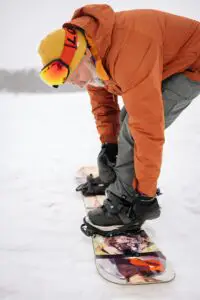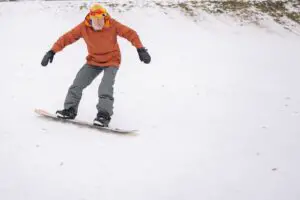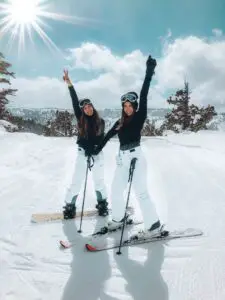Are you ready to hit the slopes and shred some powder? Well, before you strap on your boots, there’s something you need to know.
Can a snowboard be too short for you? The answer might surprise you. In this article, we’ll explore the importance of choosing the right snowboard length and delve into the benefits and drawbacks of riding a shorter board.
So grab your gear and get ready to discover how finding the perfect snowboard length can take your performance to new heights!
Key Takeaways
- Choosing a snowboard that is too short can result in instability and difficulty balancing.
- Shorter boards may struggle with flotation in deep snow or at high speeds.
- Matching the snowboard length to your height, weight, and skill level is essential for stability and control.
- Skill level impacts the appropriate snowboard length, with beginners benefiting from shorter boards for easier control and advanced riders preferring longer boards for speed and stability.
The Importance of Choosing the Right Snowboard Length
Choosing the right snowboard length is crucial because if it’s too short, you won’t have enough stability and control. When you’re out on the slopes, having a snowboard that matches your height, weight, and skill level is essential for an enjoyable experience.
A board that is too short may feel twitchy and unstable under your feet, making it difficult to maintain balance and maneuver effectively. Additionally, shorter boards can struggle with floatation in deep snow or at higher speeds.
On the other hand, a board that is too long may be harder to turn and maneuver in tight spaces. By selecting the appropriate length for your snowboard, you can maximize your performance and confidence on the mountain, allowing you to fully embrace the exhilarating world of snowboarding.
Factors to Consider When Selecting Snowboard Length
When it comes to selecting the right snowboard length, there are several factors to consider.
First and foremost is your ideal rider weight, as this will determine the stability and maneuverability of the board.
Additionally, you should take into account the type of terrain and conditions you’ll be riding in, as different lengths excel in different environments.
Lastly, your skill level will also have an impact on the appropriate snowboard length for you. Beginners typically opt for shorter boards for easier control, while advanced riders may prefer longer boards for increased speed and stability.
Ideal Rider Weight
To determine if a snowboard is too short for you, you should consider your ideal rider weight. Your ideal rider weight refers to the weight range that a snowboard is designed to accommodate effectively. Snowboards are typically designed with specific rider weight ranges in mind, as this directly impacts performance and maneuverability on the slopes.
If you choose a snowboard that is too short for your weight, it can result in unstable rides and difficulties maintaining control. On the other hand, selecting a snowboard that is too long can make turning more challenging and limit your ability to execute tricks or maneuvers.
To find the right snowboard length based on your ideal rider weight, consult manufacturer guidelines or speak with an experienced professional at a reputable snowboarding shop. They can provide expert advice tailored to your skill level and riding style, ensuring you choose the appropriate length that will enhance your overall experience on the mountain.
Terrain and Conditions
Riding in different terrains and conditions requires adapting your snowboarding technique to ensure stability and control.
When facing icy slopes, you need to maintain an aggressive edge hold and make precise turns to prevent slipping.
On powder days, you’ll want to shift your weight back to keep the nose of your board afloat, allowing for smoother turns.
Riding through bumps and moguls demands quick reflexes and the ability to absorb shocks with flexed knees.
In the terrain park, mastering tricks like jumps and rails requires balance, coordination, and confident landings.
Adapting your technique based on the specific terrain or condition ensures that you can handle any challenge with ease, giving you a sense of belonging among fellow riders who share a love for conquering diverse snow-covered landscapes.
Skill Level Impact?
Your skill level impacts your ability to adapt and handle different terrains and conditions on the snowboard. As a rider, it’s crucial to understand how your skill level can affect your overall experience.
If you’re a beginner, opting for a shorter board can provide more maneuverability and control, making it easier to navigate through various terrain features such as bumps or trees.
However, as you progress in your skills and become more confident on the slopes, riding a longer board may be more suitable. A longer board offers better stability at higher speeds and improved floatation in deeper snow. It allows for smoother turns and increased edge hold on steeper slopes.
Ultimately, choosing the right length of snowboard that matches your skill level is essential for maximizing performance and enjoying every ride on the mountain.
Benefits of Riding a Shorter Snowboard
When it comes to riding a shorter snowboard, you can expect increased maneuverability in tight spaces, improved park performance, and easier control overall.
With a shorter board, you’ll have the flexibility to navigate through narrow paths and make quick turns effortlessly. Additionally, the reduced length allows for better tricks and stunts in the terrain park, giving you more opportunities to showcase your skills.
Overall, opting for a shorter snowboard will provide you with enhanced agility and responsiveness on the slopes.
Maneuverability in Tight Spaces
To increase maneuverability in tight spaces, you’ll want to consider whether a shorter snowboard is right for you. A shorter snowboard allows for quicker turns and easier control, making it ideal for navigating through narrow paths or crowded slopes. The reduced length reduces the swing weight, allowing you to shift your board more effortlessly.
Additionally, shorter boards are often lighter, which further enhances agility and responsiveness. However, keep in mind that while a shorter board excels in maneuverability, it may sacrifice stability at higher speeds or in deep powder conditions. Finding the right balance between length and performance is crucial when choosing a snowboard that fits your riding style and preferences.
Increased Park Performance
Looking to improve your park performance? Consider a board with more flex for better tricks and jumps. Having a snowboard with increased flexibility allows for greater maneuverability and control when navigating the features of a terrain park.
The added flex provides enhanced responsiveness, enabling you to effortlessly execute spins, grabs, and presses. With this type of board, you’ll experience improved pop off jumps and rails, allowing for higher and smoother landings.
Additionally, the increased flex helps absorb impacts from landing hard tricks or jumping onto flat surfaces. This not only enhances your overall riding experience but also reduces the risk of injuries.
Easier to Control
Having a board with more flex can make it easier for you to control your movements on the slopes. When your snowboard has increased flexibility, it becomes more responsive to your actions, allowing for smoother turns and better maneuverability. Here are some reasons why a flexible board can enhance your riding experience:
-
Improved edge-to-edge transitions: With a flexier board, you’ll find it easier to shift from one edge to the other, making quick turns effortless.
-
Enhanced stability: The added flex helps absorb vibrations and uneven terrain, providing a more stable ride.
-
Increased forgiveness: A flexible board is more forgiving of mistakes, allowing you to recover from errors and maintain control.
- Better park performance: More flex enables you to easily press and butter on rails or boxes, enhancing your freestyle skills.
Drawbacks of Riding a Shorter Snowboard
Riding a shorter snowboard may limit your stability and control on fast or uneven terrain. While a shorter board offers benefits like maneuverability and ease of turning, it also has its drawbacks.
One major drawback is reduced stability at high speeds. The shorter length means less edge contact with the snow, making it harder to maintain balance when cruising down steep slopes or carving aggressively.
Additionally, a shorter board may struggle to absorb shocks and vibrations from uneven terrain. This can result in a rougher ride and increased fatigue for riders.
If you’re an advanced rider who enjoys riding at high speeds or tackling challenging terrains, opting for a longer snowboard would provide better stability and control, ensuring an enjoyable and confident experience on the mountain.
How to Determine the Ideal Snowboard Length for You
Deciding on the ideal length for your snowboard depends on factors such as your weight, height, and preferred riding style. To determine the right length for you, consider the following:
- Weight: Heavier riders may benefit from a longer board to provide stability and prevent sinking in deeper snow.
- Height: Taller riders generally find longer boards more comfortable, as they offer better control and balance.
- Riding Style: Freestyle riders often prefer shorter boards for increased maneuverability, while freeride enthusiasts opt for longer boards to handle higher speeds and varied terrain.
- Personal Preference: Ultimately, it comes down to what feels good to you. Experiment with different lengths to find the one that suits your style and gives you confidence on the slopes.
Common Misconceptions About Short Snowboards
Don’t let the common misconceptions fool you, a shorter board can still provide stability and control on the slopes.
Many people believe that longer boards are the only way to go when it comes to snowboarding, but this is not always the case. Shorter boards can offer advantages such as increased maneuverability and quicker edge-to-edge transitions. They are also easier to handle for beginners or riders with smaller frames.
The key is finding the right balance between length and width for your specific needs and riding style. It’s important to consider factors such as your weight, height, skill level, and the type of terrain you’ll be riding on.
Tips for Maximizing Performance on a Short Snowboard
When it comes to getting the most out of a shorter board, it’s important to focus on technique and body positioning. By following these tips, you can maximize your performance on a short snowboard:
- Stay centered: Keep your weight evenly distributed over the board to maintain control and stability.
- Engage your edges: Use your edges to initiate turns and maintain grip on icy or hard-packed conditions.
- Utilize quick turns: Shorter boards are more maneuverable, so take advantage of their agility by making quick, snappy turns.
- Use your body: Be aware of your body positioning and use subtle movements to control the board’s direction.
Frequently Asked Questions
How Does the Length of a Snowboard Affect Its Performance?
The length of a snowboard directly affects its performance. A shorter board offers quick turns and maneuverability, ideal for park or freestyle riding. However, it may sacrifice stability and control at high speeds or in deep powder.
Can Riding a Shorter Snowboard Cause Any Safety Issues?
Riding a shorter snowboard can increase maneuverability, but it may come with some safety risks. A shorter board can be less stable at high speeds and have reduced float in deep powder. Be cautious!
Are Shorter Snowboards More Suitable for Beginners or Advanced Riders?
Shorter snowboards can be more suitable for beginners or advanced riders depending on their preferences and riding style. They offer better maneuverability and control, making them ideal for those who value agility on the slopes.
Can I Use a Shorter Snowboard for Freestyle or Park Riding?
Yes, you can use a shorter snowboard for freestyle or park riding. It offers more maneuverability and control, allowing you to perform tricks with ease. However, make sure it still provides enough stability for your skill level.
What Are the Advantages of Using a Longer Snowboard Instead of a Shorter One?
Using a longer snowboard provides more stability at high speeds, increased edge hold for carving, and improved float in deep snow. It also offers better stability on landings and allows for greater control during aggressive riding.
Conclusion
In conclusion, choosing the right snowboard length is crucial for optimal performance on the slopes.
While a shorter snowboard may offer benefits such as increased maneuverability and control, it is important to consider your skill level and riding style.
Remember, like Goldilocks seeking the perfect fit, finding the ideal snowboard length requires careful consideration of various factors.
So next time you hit the mountains, make sure your snowboard is just right to experience a ride that feels like a dream come true.



